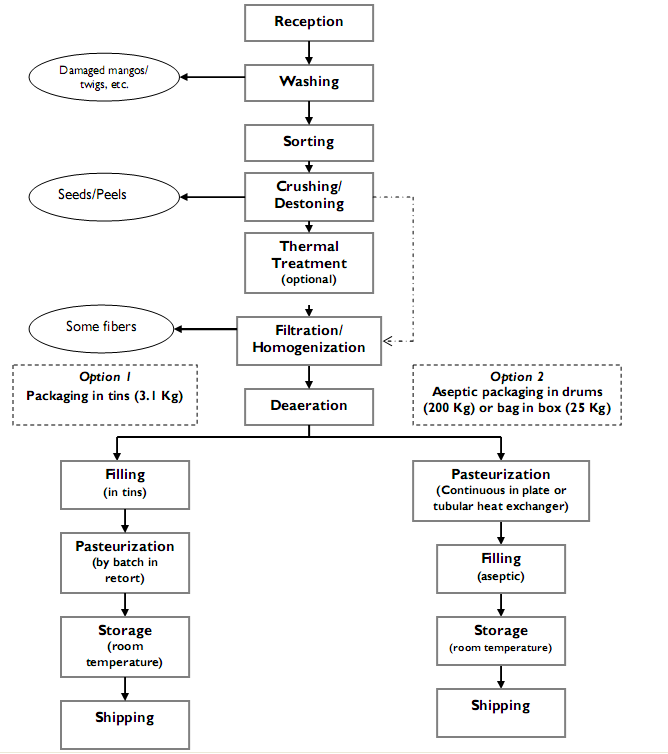Fruit Puree What's a fruit Puree? |
|
Fruit Puree is called 'Fruit Pulp'
It consists of a preparation comprising finely ground fruit to which sugar mat be added (0% - 10% max). Traditionally added to fruit purees, sugar serves primarily as a preservative. In fact fruit puree without sugar, tends to oxidize rapidly
Certain more fragile fruits, such as bananas, peaches, pears require the addition of ascorbic acid & citric acid to preserve them. |
|
|
|
|
Sugar also has the effect of helping fruit hold their color & flavour, as well as making the puree smoother.
Flavourings, colourings & other preservatives are to be avoided as a general rule. Their use must be indicated according to legalization: fruit puree must be as close as possible to fresh fruit, naturally.
Fruit Puree, unlike vegetables puree, is uncooked: it consists of the puree of raw fruit. It is distinguished from its manner from compote.
Fruit Puree is a raw material, an ingredient. Chefs use it mainly to make fruit desserts. For them, fruit puree is 'Ready to use Fruit' Top
How to recognize the quality of the fruit Puree? |
|
|
Brix: |
Brix is the percentage of the of dry matter contained in 100g of product.
For a raw fruit, it allows us to see if the fruit is naturally of the right sweetness, proof of perfect ripeness & ensures a pleasing taste. If we compare, two purees of the same fruit, with the same composition, & in particular, the same percentage of added sugar, a lower Brix suggests the use of fruit which was not ripe when picked or full of water |
PH: |
The PH is the scale of acidity on a scale of 1 to 14 |
Flavour: |
When testing the Fruit Puree, we must a taste identical to fresh fruit & recognize its subtleties: taste must not be enhanced by artificial flavourings. |
Colour: |
The colour must be vivid, bright & identical to fresh fruit. It should not be dull or dark, sign of cooked puree such as compote. |
Texture: |
Certain purees are very runny, almost like juice, such as those of passion fruit or citrus fruit.
Others are especially thick such as those of chestnuts or green apples
But you should first & foremust look for homogeneity & the absence of settling, sign that no water has been added. |
|
|
|
|
Different Methods of preserving?
There are several methods of preserving purees: Room Temperature, Refrigerated or Frozen While these different methods of preserving are more or less convenient, depending on their storage capacity, they all affect the affect the quality of the puree itself to some extent. |
|
Fruit Puree stored at room temperature (in a jar, plastic bottle or Tetra Pack). It is very convenient as it can be stored anywhere. However, the quality is nowhere as good as the other methods of preserving since pasteurization needs to be pushed to the maximum 'high pressure' to sterilize the product
Refrigerated Fruit Puree (+4°C - +6°C) (in an aluminum pouch with re-sealable cap). It has the advantage of being immediately available. It is very convenient, but needs to be kept in the fridge. It suffers less during pasteurization than room temperature puree.
Frozen Fruit Puree (-18°C) (in a plastic box). Offers the highest quality puree possible. Just one drawback, the time allocated to defrosting.
|
|
|
| |
Processing
The fruit used to prepare the fruit purees are meticulously selected (origin & variety).They are harvested at full ripeness, 'in season' & only once a year, only the best fruit is selected.
After numerous acceptance inspections at receiving, the fruits are stored before being processed.
Ssome fruits require specific methods of preparation: peeling, stoning/pitting, cleaning,..... etc.
Then they are ground with sugar, strained (the seeds are removed) & finally flash pasteurized.
Flash pasteurization entails heating the product briefly at a very high temperature to kill the germs, ensuring optimal hygiene, & then cooled immediately.
Uses |
Click on the photo to view full Design  |
|
|
| |
|
- Ice-creams & Sorbets
- Mousses preserved in verrines, cups & entremets
- Coulis & Sauces
- Fruit Juices, Cocktails, Smoothies
- Citrus Fruit Tarts (Lemon, Mandarin, Oranges)
- Coatings & Toppings
- Cold Soups
- Jelly Pastes
|
|
|
|
|
Packing & Storage |
|
Packing: |
In Aseptic Bags inside Conical Steel Drum, each pallet holds 4 drums |
Shelf Life: |
18 Months from the printed production date |
Storage: |
Should be covered, stored in a cool & dry place, store in ambient temperature (+25°C), & protected from moisture & direct sunlight. For Strawberry Pulp; store in +5°C. Consume once the bag is opened or keep frozen, avoid puncturing of bag, free of preservatives or artificial colors |
|
| |
Varieties |
| |
|
|
|
|
|
|
|
